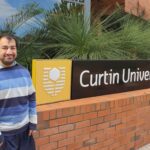Pancreatic cancer patients in Western Australia will be offered a medicinal cannabis compound in clinical trials conducted by Curtin University. It is hoped the substance will significantly increase patients’ lifespans.
Pancreatic cancer is one of the most deadly forms of the disease. Sitting behind the stomach, where the ribs meet the sternum, the pancreas is a gland that produces digestive enzymes and insulin.
Cancer in this gland is a silent killer, with most patients unaware they are ill until the condition is far advanced. Only three per cent of patients survive for five years after diagnosis, compared with 87 per cent for breast cancer and 98 per cent for testicular cancer.
Now, Professor Marco Falasca from the Curtin Health Innovation Research Institute believes he has found a way to halt the progression of this devastating cancer. With encouraging results in laboratory tests, his next step is to trial the treatment in humans.
“Life expectancy for pancreatic cancer patients has barely changed in the past 40 years. There are few treatments available, and therapeutic strategies and new treatments are urgently needed,” Falasca says.
His research has examined the impact of cannabidiol – a medicinal cannabis compound – on the chemotherapy drug gemcitabine.
“We worked with in vitro cancer cells, then we moved on to a more sophisticated transgenic animal model of pancreatic cancer, using mice who had developed a tumour from introduced genetic material.
“The histology of the mouse tumour is similar to a human tumour. As with people, there is one specific gene that is mutated in 95 per cent of pancreatic cancer patients. This mutation drives the cells to develop pancreatic tumours.”
His results showed that mice with pancreatic cancer survived nearly three times longer if they were treated with cannabidiol and gemcitabine – an outcome Falasca hopes to replicate in people.
His team is collaborating with Perth-based Fiona Stanley Hospital to find 30 pancreatic cancer patients to participate in a treatment trial.
Cannabidiol is a naturally occurring compound derived from the hemp plant. Known to reduce pain and anxiety, it is an essential component of medicinal cannabis, used to treat bipolar disorder, seizures, multiple sclerosis, Parkinson’s disease and schizophrenia.
The compound is an antagonist of the cancer receptor in pancreatic cells – a protein on the cell surface responsible for switching on cellular activity – and works by blocking the protein and inhibiting the growth of the tumour.
While there is anecdotal evidence of success in using medicinal cannabis among cancer patients, Falasca waits to regulate and monitor the results of his research.
“Trials give us proper validation and proper demonstration that it is working, so other people can use this. We need to know there are no side effects, no complications; it is very important for clinical integrity.”
Trial participants will take the cannabidiol sublingually (under the tongue) or rectally. It will involve a period of treatment, followed by a break where the team will assess whether the treatment is working or if it is in the patient’s best interest to alter the dosage.
“We need to try different combinations of the drugs – single cannabidiols, mixed cannabidiols or dry medicinal cannabis – and work out the best one. We also want to try our treatment in combination with other drugs and therapies.”
The cannabidiol used in the trial will be produced in Germany and the Netherlands, and supplied by Australian pharmaceutical group Zelda, with the research and results processed in the CHIRI laboratories at Curtin University.
Having cannabidiol already approved for use in clinics means if the trial is successful, the treatment could be made available to all patients with relative ease.
“If we can reproduce these effects in humans, it could be in use in cancer clinics almost immediately, rather than waiting for authorities to approve a new drug,” Falasca says.
For Falasca, finding a cure would be the pinnacle of a long and productive career in oncology research, however, given the high morbidity of the disease, he believes that successful clinical trials may not necessarily equate to a cure.
“My ambition is to cure it, but this cancer is very aggressive and you have to be realistic. It might not just be about the cure, it’s about managing it and getting it under control.
“If we can counteract the tumours, we can improve survival rates. But we can also work towards giving options to patients – another drug, another therapy – to extend a patient’s lifetime. And there are a few patients who survive, so we have a window of hope for those patients.
“We could make that little bit of hope a bit bigger.”
Falasca’s research is supported by the Pancreatic Cancer Research Fund and the Avner Pancreatic Cancer Foundation, and also involves researchers from D’Annunzio University in Italy, Fondazione Edo ed Elvo Tempia and The Beatson Institute for Cancer Research in Scotland.
The full paper, ‘GPR55 Signalling Promotes Proliferation of Pancreatic Cancer Cells and Tumour Growth in Mice, and its Inhibition Increases Effects of Gemcitabine’, was published in the journal, Oncogene.



